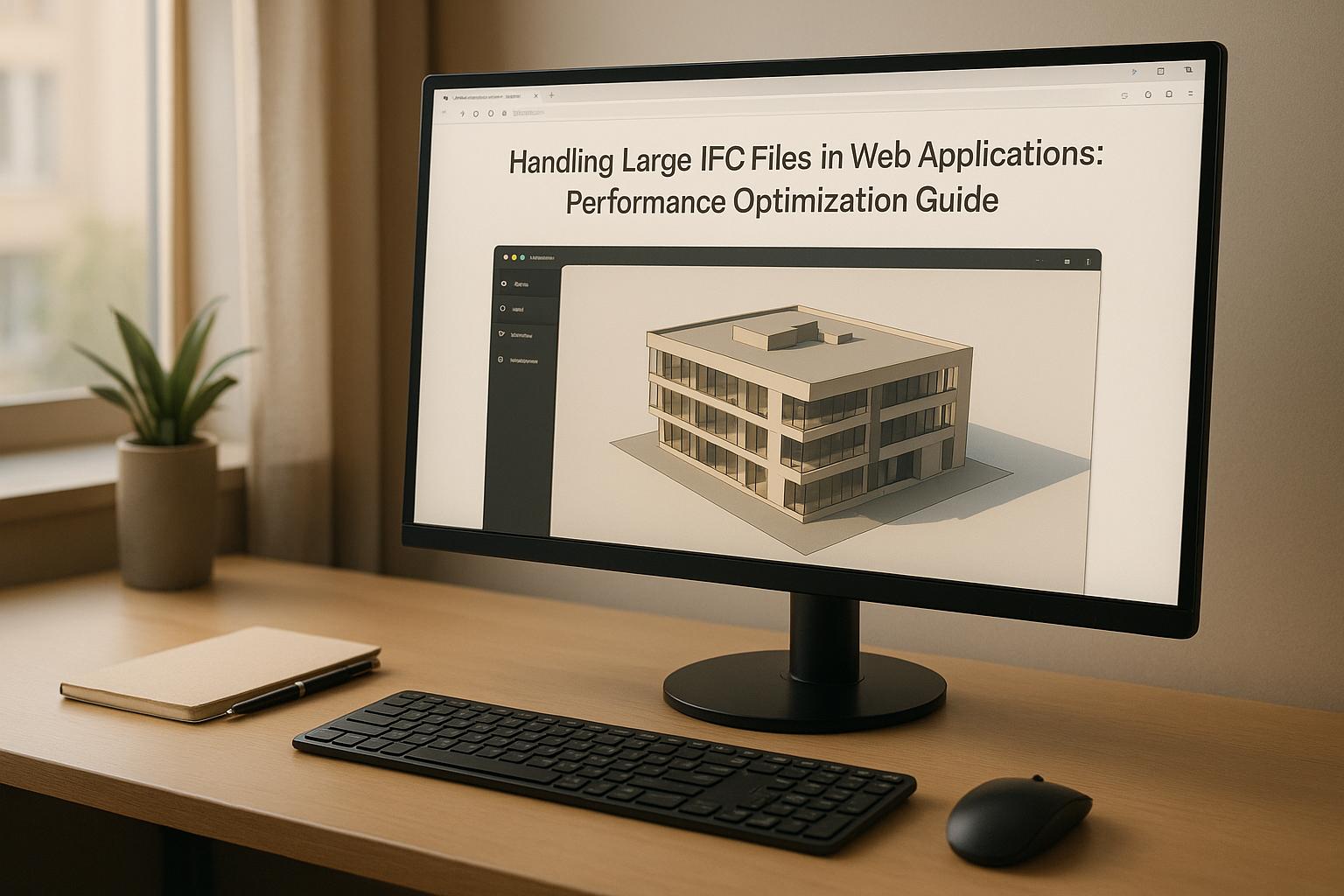Handling Large IFC Files in Web Applications: Performance Optimization Guide
Taher Pardawala August 17, 2025
Working with large IFC files in web applications can be challenging, but it doesn’t have to be. These files, often exceeding 500 MB, can cause slow loading, high memory usage, and browser crashes. However, by employing smarter parsing, dynamic loading, and memory management techniques, you can ensure smooth performance and user-friendly experiences.
Key Takeaways:
- Dynamic Loading: Load only the parts of the IFC file users need, instead of the entire dataset.
- Incremental Parsing: Process data in smaller chunks to reduce memory strain and improve responsiveness.
- Compression & Preprocessing: Simplify geometry, reduce polygon counts, and compress files to cut down load times.
- Server-Side Optimization: Use spatial indexing, file splitting, and caching to prepare files before they reach the browser.
- Efficient Rendering: Leverage tools like WebGL and Three.js for high-speed 3D rendering.
- Memory Management: Use lazy loading and actively clean up unused data to prevent memory overload.
With tools like IFC.js, Web-IFC, and Draco 3D, combined with expert services like AlterSquare, developers can transform IFC file handling into a smooth, efficient process. Whether you’re building a visualization platform or optimizing a legacy system, these strategies ensure better performance and usability.
Common Problems with Large IFC Files
What Are IFC Files?
IFC files act as digital blueprints for building information modeling (BIM). They store everything from geometry and materials to relationships and project details, making them essential for seamless collaboration across different platforms. Since the IFC format is an open standard, any software that supports it can read and write these files without being tied to proprietary systems. However, this flexibility comes with a trade-off – IFC files are inherently complex, which presents unique challenges when processing them, especially in web browsers.
Performance Issues in Web Browsers
The complexity of IFC files becomes a hurdle when they are processed in web browsers. These files often need to be fully downloaded and converted into 3D objects, which places a heavy demand on both memory and CPU resources. This process can slow down performance significantly, sometimes triggering unresponsive script warnings or causing stuttering as the system struggles with memory cleanup.
How Poor Performance Affects Users
When IFC files take too long to load, it disrupts workflows and leaves users frustrated. Waiting for a model to render, especially on everyday devices, can hinder collaboration and damage the perception of an application’s quality. Streamlining how these files are handled not only speeds up performance but also ensures a smoother, more reliable experience for professionals relying on these tools in their day-to-day work.
Better File Parsing and Loading Methods
Handling large IFC files in web applications can be challenging, especially when it comes to browser performance. To address this, smarter parsing and loading methods are essential. Instead of making users wait for the entire model to load, these techniques focus on prioritizing key content and managing memory efficiently.
Dynamic and Incremental Loading
Dynamic loading is a game-changer for managing IFC files. It works by loading only the parts of the file that are immediately needed. For example, the application might load the basic structure first, then fetch more detailed data as the user interacts with the model. This approach prevents browsers from being overwhelmed and keeps them responsive.
Incremental parsing takes this a step further by processing the file in small, manageable batches. By organizing IFC data spatially, the system can focus on loading sections relevant to the user’s current view. Together, these strategies not only improve performance but also pave the way for further optimization through preprocessing and compression.
File Preprocessing and Compression
Preprocessing IFC files before they reach the browser is another effective way to reduce file sizes without losing critical building information. One common technique is geometry simplification. Many complex surfaces and mechanical components have a level of detail that isn’t necessary for web visualization. By reducing polygon counts and simplifying intricate shapes while maintaining visual accuracy, files load faster and still look great.
Compression algorithms, such as binary encoding and mesh optimization, also play a crucial role. These techniques shrink file sizes while preserving essential details. Additionally, optimizing textures and materials – like converting high-resolution images into web-friendly formats – ensures faster load times without sacrificing quality.
Server-side preprocessing takes these methods even further, handling intensive tasks before the files reach the browser and ensuring smooth performance.
Server-Side File Preparation
Server-side processing optimizes IFC files in ways that significantly reduce load times. Techniques like spatial indexing, file splitting, and caching make it easier for web applications to handle large models.
- Spatial indexing organizes data so that specific components can be quickly located and retrieved without scanning the entire file. For instance, if a user searches for a particular element, the indexed data ensures rapid access.
- File splitting divides large IFC files into logical sections – such as structural elements, mechanical systems, or architectural details – that load independently. This means users can focus on one part of the model without waiting for unrelated components to load.
- Caching strategies store frequently accessed elements, like common material definitions or standard geometric shapes, so they’re readily available for future use. This results in faster load times for subsequent users.
Server-side preparation also allows for format conversion, creating multiple optimized versions of the same IFC file. These tailored versions can cater to different needs, whether it’s a quick overview, a detailed technical review, or mobile device compatibility. This flexibility ensures smooth performance across various scenarios and devices.
Improved Rendering for Better Performance
Once file parsing and loading are optimized, the next step is ensuring smooth rendering. Efficient rendering is crucial for keeping web applications responsive, especially when dealing with intricate architectural data. This step ensures that the platform can handle complex visualizations without compromising performance.
Using WebGL and Three.js
WebGL allows for high-speed 3D rendering by tapping directly into the GPU’s power [1]. To make WebGL more accessible, Three.js acts as a user-friendly library, simplifying the process of rendering complex IFC models [1]. For teams working with IFC files, Three.js is a game-changer, as it removes many of the technical hurdles involved in displaying detailed architectural geometry.
Working with IFC Loaders
IFC loaders play a critical role in converting raw architectural data into formats that are optimized for use with Three.js. By using these loaders, developers can efficiently render large and detailed IFC files, making it easier to visualize intricate architectural models in web-based applications. This approach ensures that even complex designs are displayed smoothly and effectively.
sbb-itb-51b9a02
Memory Management and Browser Performance
After refining rendering techniques, managing memory efficiently becomes a key factor in ensuring smooth browser performance. Even with optimized rendering, poor memory management can lead to crashes, freezes, or an overall frustrating user experience. This challenge becomes even more pronounced when working with large architectural models that demand significant amounts of RAM.
Lazy Loading and Memory Cleanup
Lazy loading is a smart way to handle IFC files by loading data only when it’s needed. This method helps keep initial memory usage low, especially for complex projects.
The secret to making lazy loading work well is timely cleanup. When users move away from a specific part of a model, the related geometries and textures should be released. Developers need to actively remove references to Three.js objects, dispose of geometries, and clear texture data to free up memory.
A consistent memory cleanup routine is critical. Whenever new IFC data is loaded, the application should discard unused materials, geometries, and textures. Three.js provides disposal methods like geometry.dispose() and material.dispose() that must be manually called. Without these cleanups, memory usage can pile up until the browser runs out of resources.
Performance Monitoring Tools
Chrome DevTools is a powerful ally when it comes to monitoring memory usage in IFC web applications. The Memory tab offers detailed insights into heap usage, helping developers spot memory leaks and fine-tune resource allocation. The Performance tab is equally valuable, highlighting memory spikes during IFC file loading and rendering.
Taking memory snapshots can help identify which objects are consuming the most resources. By comparing snapshots before and after loading IFC files, developers can pinpoint the memory impact of specific model components.
For a quick overview, Chrome’s Task Manager provides a snapshot of memory usage across tabs and processes. It’s especially useful for detecting memory spikes. Observing memory behavior during typical user interactions can reveal opportunities for further optimization.
Partial vs. Full Model Loading
Partial model loading is a practical way to reduce memory use by loading only the visible or relevant parts of a building. This approach works particularly well for large commercial structures, where users may focus on specific floors or sections. By keeping only active components in memory, this method helps maintain stability.
On the other hand, full model loading brings all building data into memory at once, offering immediate access to every detail. While this approach suits smaller projects or scenarios where users need to navigate between various sections frequently, it comes with higher memory demands upfront.
Choosing between partial and full loading depends on user needs and system capabilities. Monitoring memory usage can guide these decisions. For example, when memory is running low, the application can dynamically unload unused components to keep performance smooth. Adopting a flexible loading strategy ensures a better balance between functionality and resource management.
Tools and AlterSquare Services

Optimizing IFC file performance in web applications becomes much simpler with the right tools and expert services. By leveraging verified tools and experienced development teams, handling IFC files can shift from being a technical hurdle to a significant advantage.
Best Tools for IFC File Management
Here’s a quick rundown of some powerful tools that can make IFC file management easier:
- IFC.js: This open-source tool is designed to efficiently stream large IFC files and process geometry in smaller, manageable parts. Its integration with Three.js and modular design allows developers to load only the components they need, keeping things lightweight and efficient.
- Three.js: A go-to for 3D rendering, this library optimizes WebGL performance to handle complex architectural data, making it essential for rendering IFC models in web applications.
- Web-IFC: A WebAssembly-based library that parses IFC files directly in the browser. It’s perfect for applications that need to extract specific building details without loading entire geometric models.
- Draco 3D: Developed by Google, this compression tool significantly reduces the size of geometric files. It works seamlessly with Three.js workflows, compressing mesh data while maintaining visual quality – ideal for detailed architectural models.
- GLTF format conversion tools: These tools bridge IFC files with web-optimized 3D formats. Converting IFC models to GLTF can drastically improve loading times for models that don’t require dynamic access to IFC properties.
By combining these tools, developers can achieve significant performance improvements, paving the way for specialists like AlterSquare to add even more value.
How AlterSquare Can Help
AlterSquare provides startups with the specialized expertise needed to create high-performance IFC applications through their engineering-as-a-service model. Their approach includes strategies like dynamic loading and memory optimization to simplify development and enhance performance.
Using technologies like Vue.js, Node.js, and WebGL, AlterSquare’s teams help startups accelerate product development without requiring in-house expertise in 3D web development. Their structured 90-day MVP program focuses on rapid prototyping, tech stack consultation, and agile development cycles, ensuring that IFC viewer concepts are transformed into functional, user-ready applications. By incorporating user feedback throughout the process, they ensure that performance enhancements align with real-world requirements.
AlterSquare also employs AI-driven development to automate many aspects of IFC file processing, which speeds up development and cuts costs. For scaling applications, their tech team augmentation services provide dedicated engineers who specialize in 3D web development and can maintain scalable architectures as user demands grow.
Real Project Examples
AlterSquare’s expertise has been put into action across various projects, showcasing their ability to optimize IFC performance:
- In one project, they improved an architectural visualization platform by implementing better memory management techniques, which led to significantly faster load times for building models.
- For a legacy building information system, they introduced incremental loading strategies, enabling the platform to handle much larger IFC files while maintaining responsive user interactions.
- A real estate visualization startup benefited from their work on level-of-detail rendering and smart caching, allowing users to explore intricate building models seamlessly. This not only improved performance but also boosted user engagement.
AlterSquare has also assisted established firms in transitioning outdated IFC workflows to modern, web-based platforms. Their zero-downtime migration strategy ensures that businesses can continue their operations uninterrupted while gradually introducing new web capabilities.
These examples highlight how combining the right tools with expert execution can turn IFC file management into a strategic advantage for businesses.
Key Points for IFC File Optimization
Optimizing IFC files for web applications hinges on efficient parsing, smart rendering, and effective memory management. These strategies ensure that large building data files, often overwhelming for browsers, can be handled smoothly and efficiently.
Efficient parsing is the starting point. Instead of loading an entire file all at once, dynamic and incremental loading methods let applications focus only on the data users need. Coupled with server-side preprocessing and compression, this approach can drastically cut down load times and improve performance.
Optimized rendering is equally important. Using tools like WebGL and Three.js, along with techniques such as level-of-detail adjustments and culling, ensures that even complex architectural data is rendered smoothly. These methods keep user interactions responsive, no matter how detailed the model.
Memory management plays a critical role in handling large datasets. Lazy loading, combined with timely cleanup of unused data, prevents memory overload. Depending on the use case, developers can choose between partial or full model loading, while monitoring tools help identify performance bottlenecks and ensure smooth operation.
In addition to these technical strategies, specialized tools and services can further simplify IFC optimization. Resources like IFC.js, Web-IFC, and Draco 3D tackle common performance issues. For applications that don’t require full IFC property access, converting IFC files to web-friendly formats like GLTF can significantly enhance load speeds.
For startups venturing into IFC-powered applications, expert services like AlterSquare provide a practical solution. Their engineering teams implement these optimization techniques, combining rapid prototyping with performance-driven development. This allows startups to build responsive applications without needing deep 3D expertise.
FAQs
How does dynamic loading enhance the performance of web apps managing large IFC files?
Dynamic loading enhances performance by focusing on loading only the essential parts of an IFC model as they’re needed, instead of processing the entire file upfront. This approach cuts down on memory usage, speeds up load times, and ensures a smoother experience when working with complex models.
Techniques such as spatial partitioning and modular code with dynamic imports take this optimization a step further. They help reduce unnecessary data processing and rendering, making it more manageable to work with large architectural datasets in a web-based environment.
What are the advantages of using tools like IFC.js and Three.js for displaying large architectural models in web applications?
Using IFC.js and Three.js can make web applications handling large architectural models much more efficient and user-friendly. IFC.js simplifies the process of working with IFC files by allowing fast parsing, editing, and rendering of detailed BIM data directly in the browser. Thanks to WebGL, it delivers smooth, client-side visualization, even when dealing with massive datasets.
Meanwhile, Three.js offers a powerful framework for creating and displaying 3D graphics. It makes it easier to build interactive and visually engaging models by supporting fluid animations, intricate textures, and advanced lighting effects. When combined, these tools provide a scalable solution for high-performance architectural visualizations, making web-based interactions and rendering seamless for users.
How does preparing large IFC files on the server improve load times and user experience in web applications?
Preparing large IFC files on the server is a crucial step in boosting both load times and overall user experience. By handling data optimization on the server side, tasks like parsing, compressing, and filtering are completed before the data ever reaches the user’s browser. This significantly reduces the size of the data being transferred over the network.
The result? Faster load times, smoother rendering, and more responsive interactions for users. This method is particularly effective for web applications managing complex architectural data, ensuring they remain efficient and scalable – even when working with massive files.








Leave a Reply